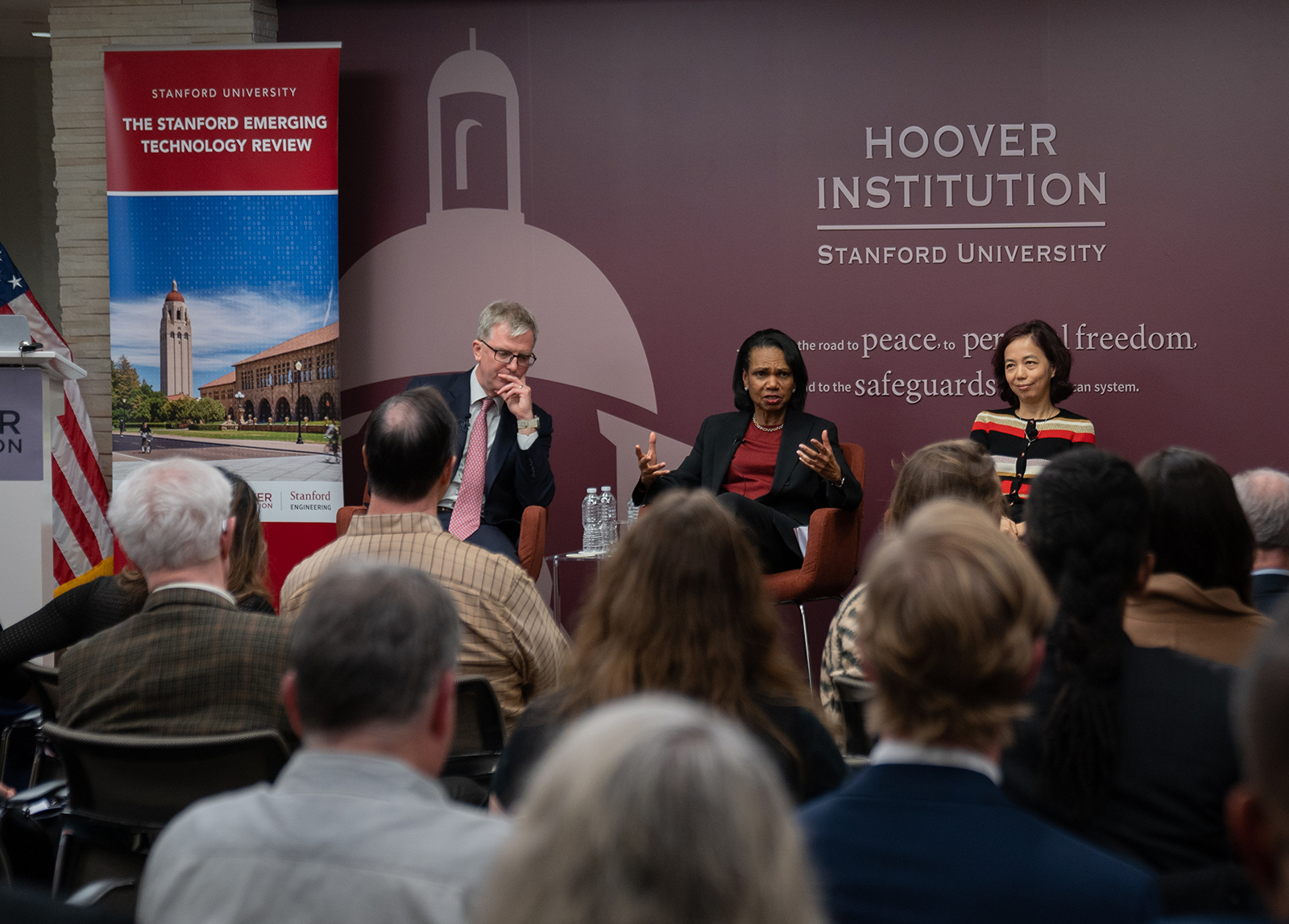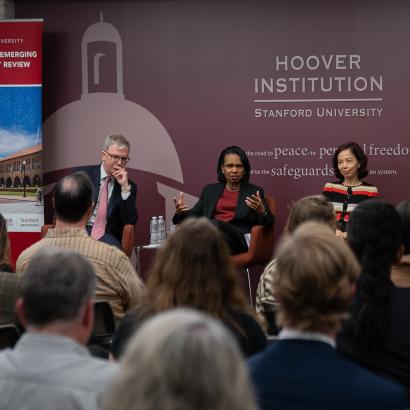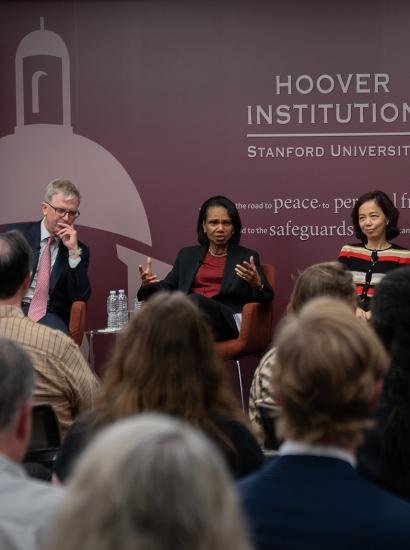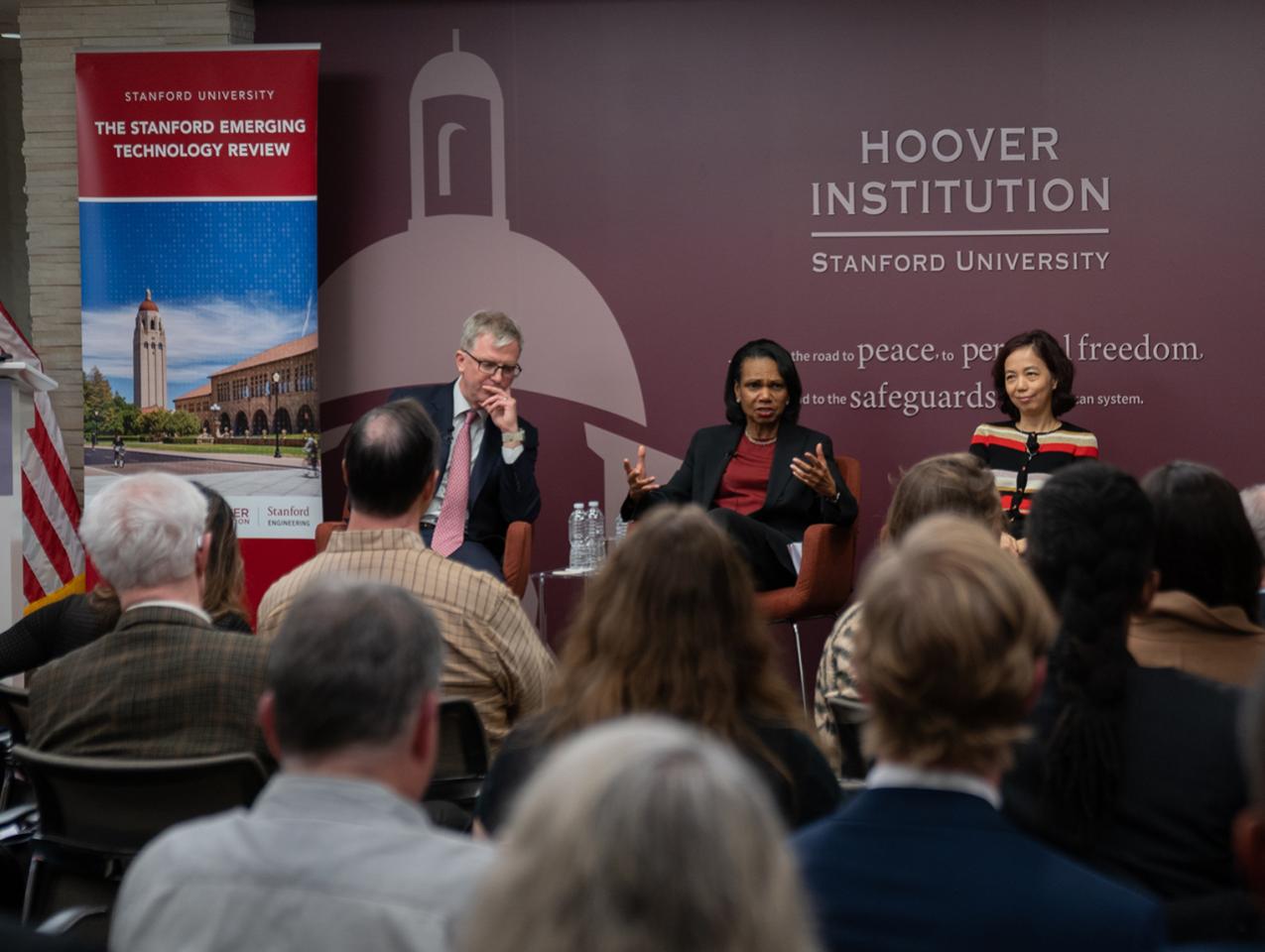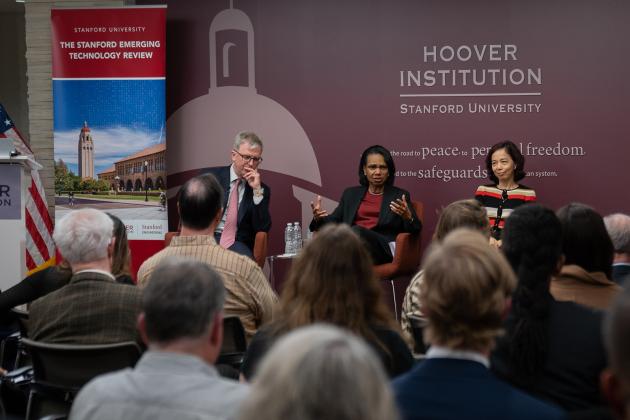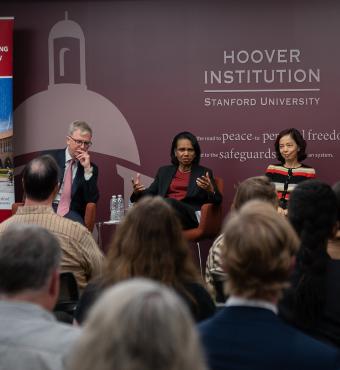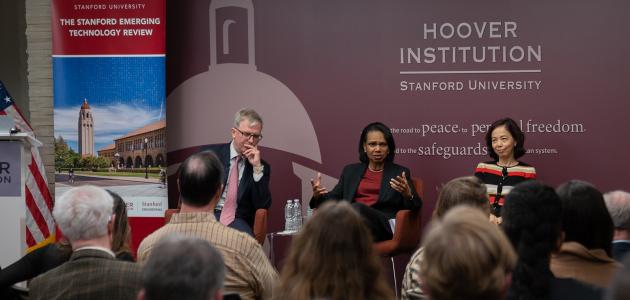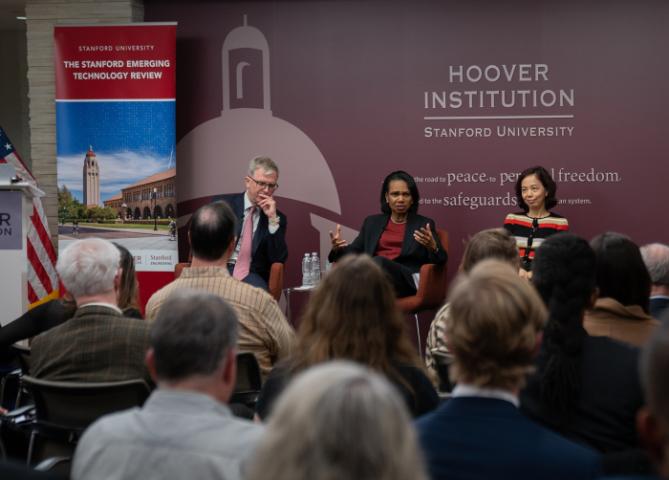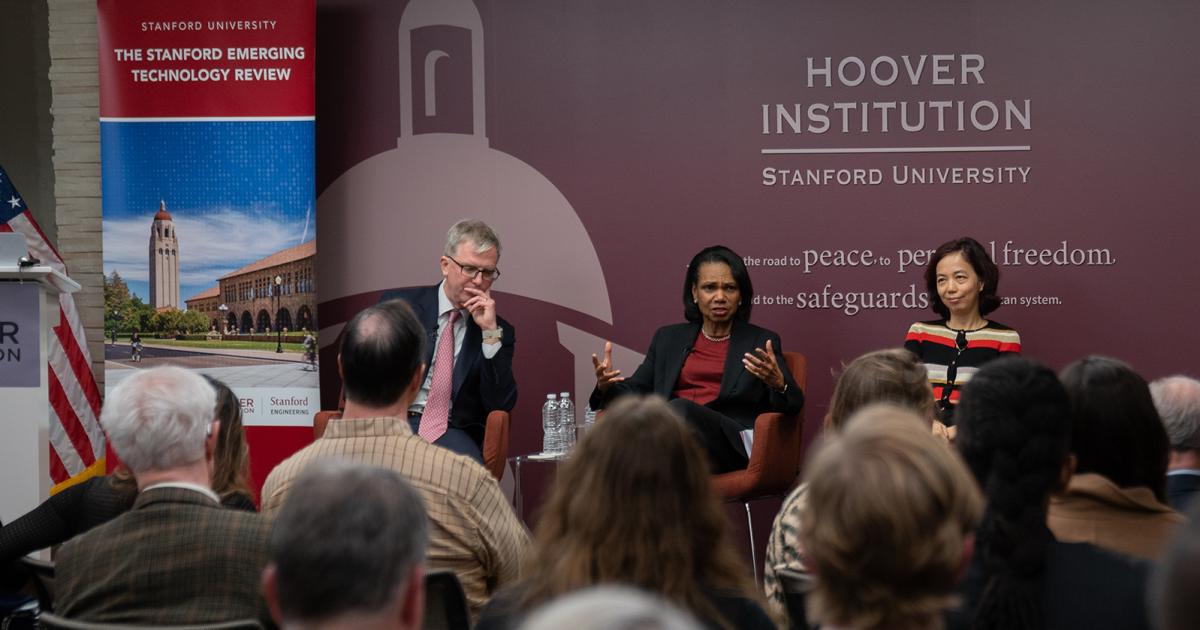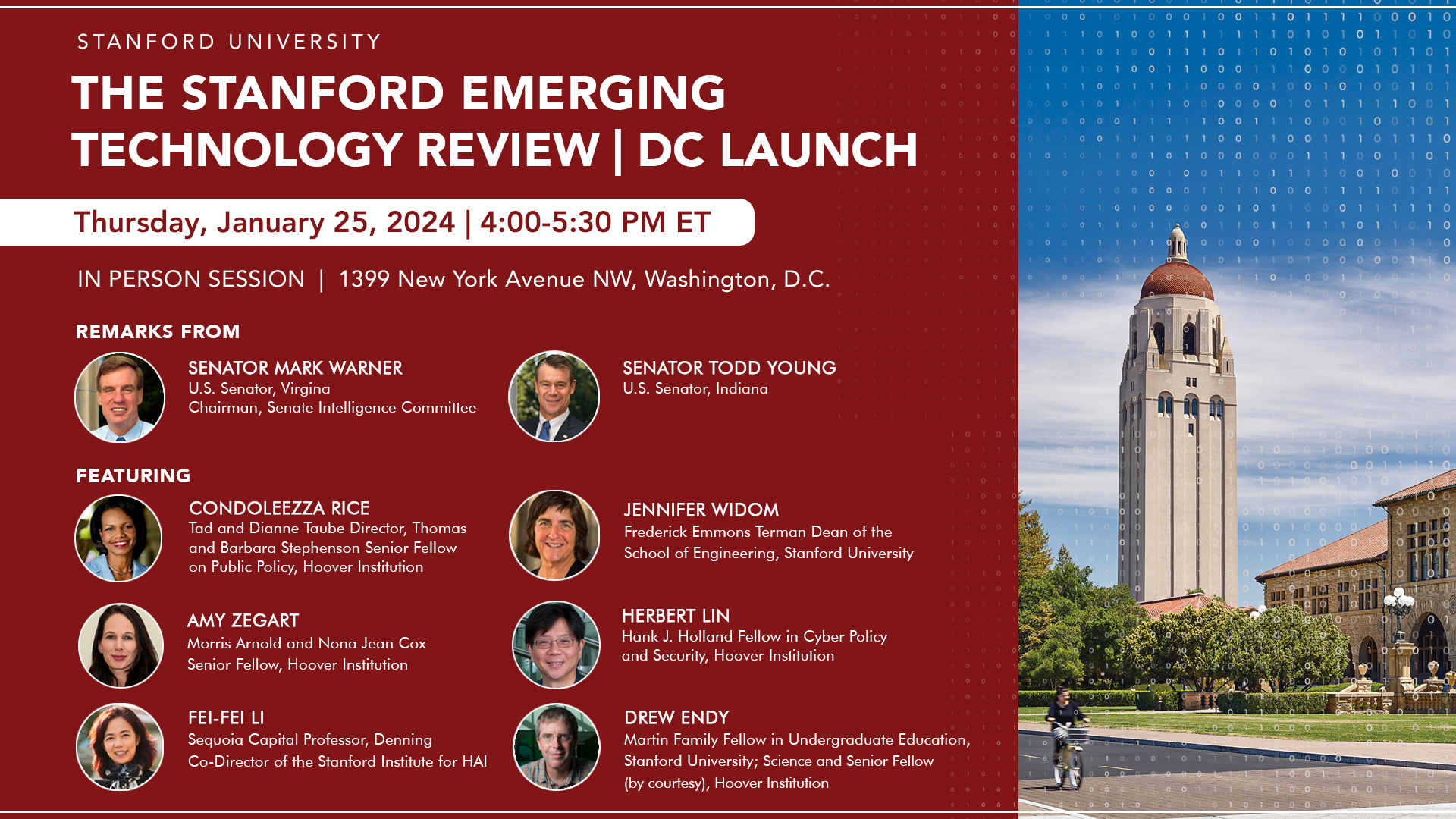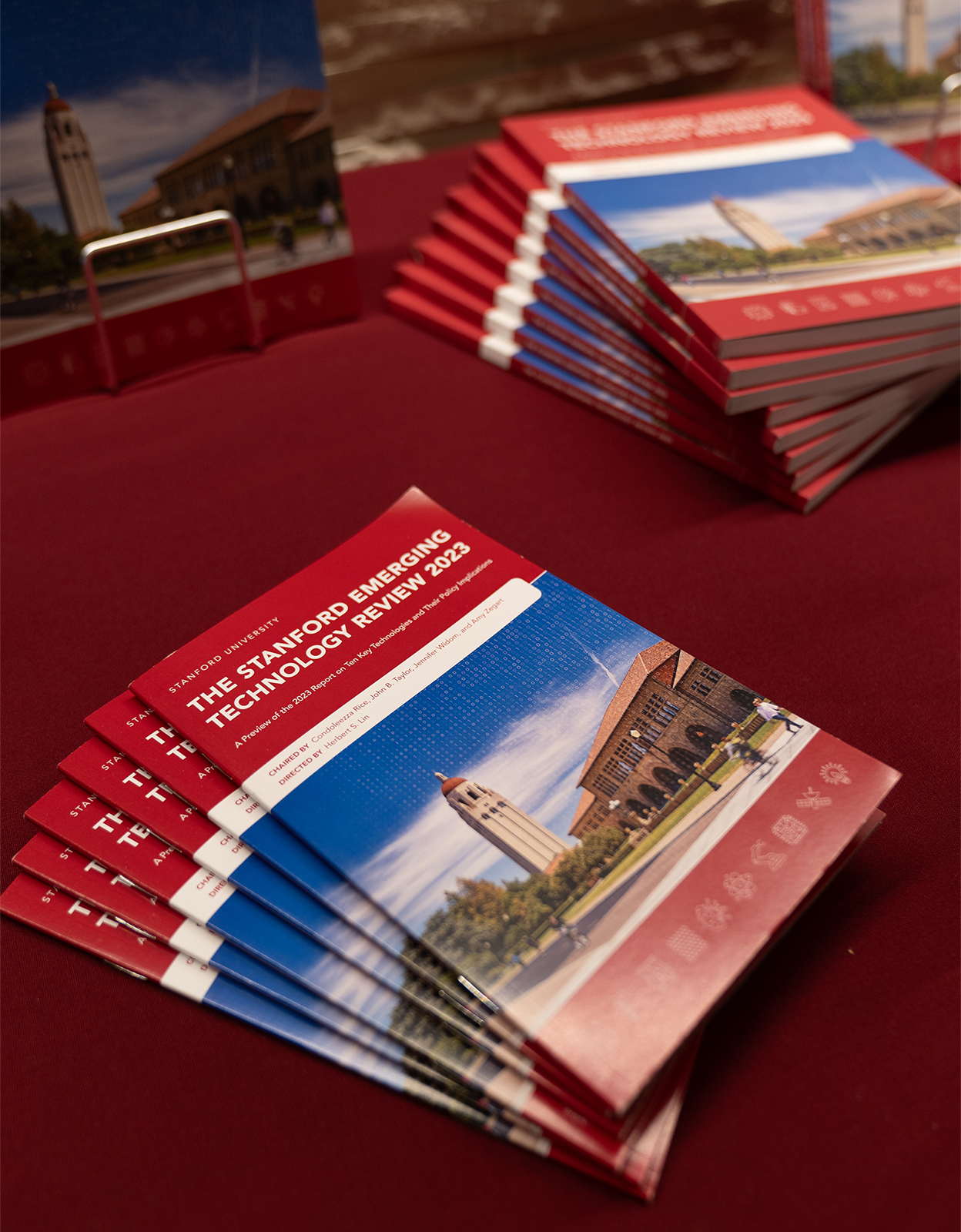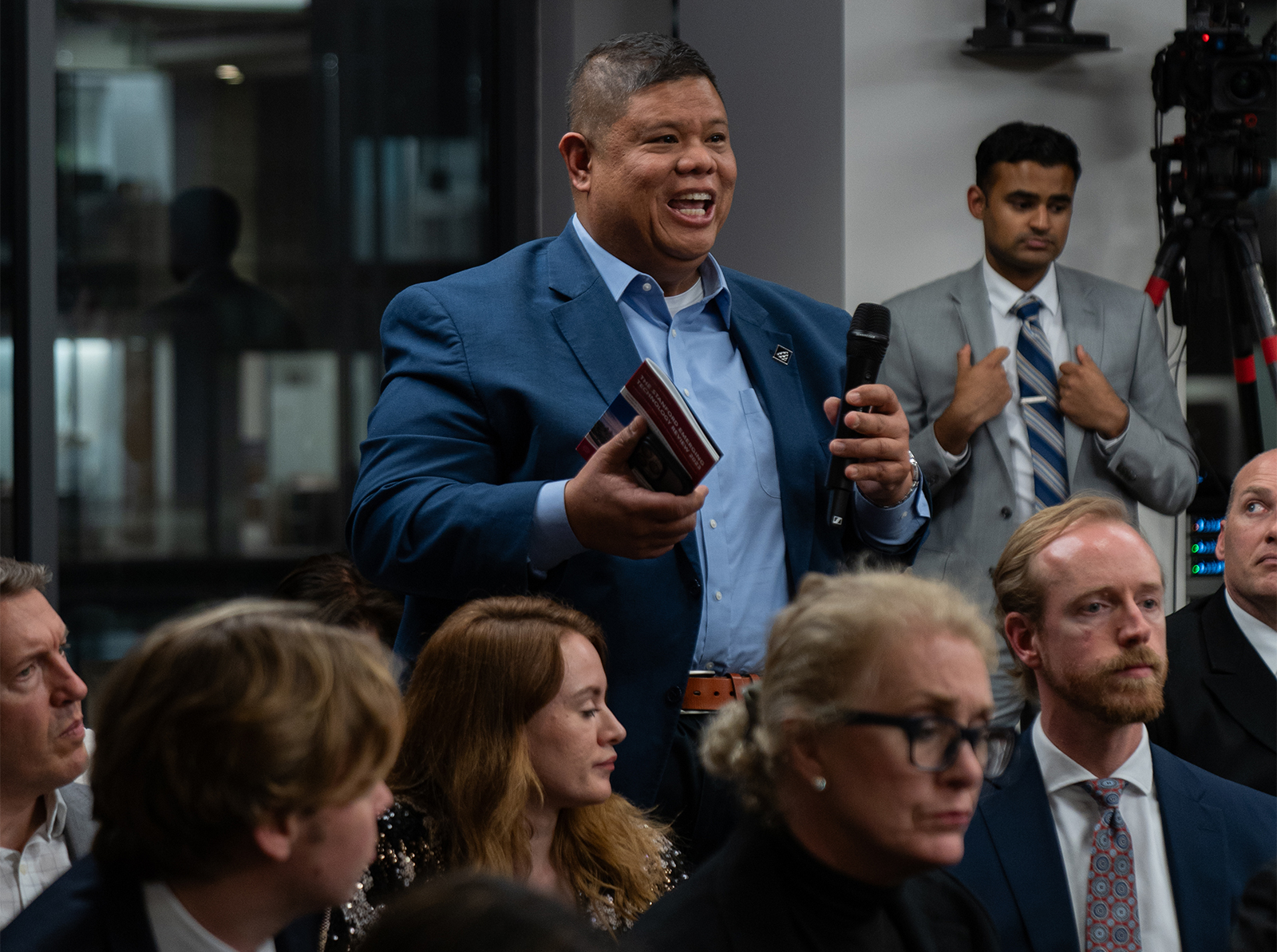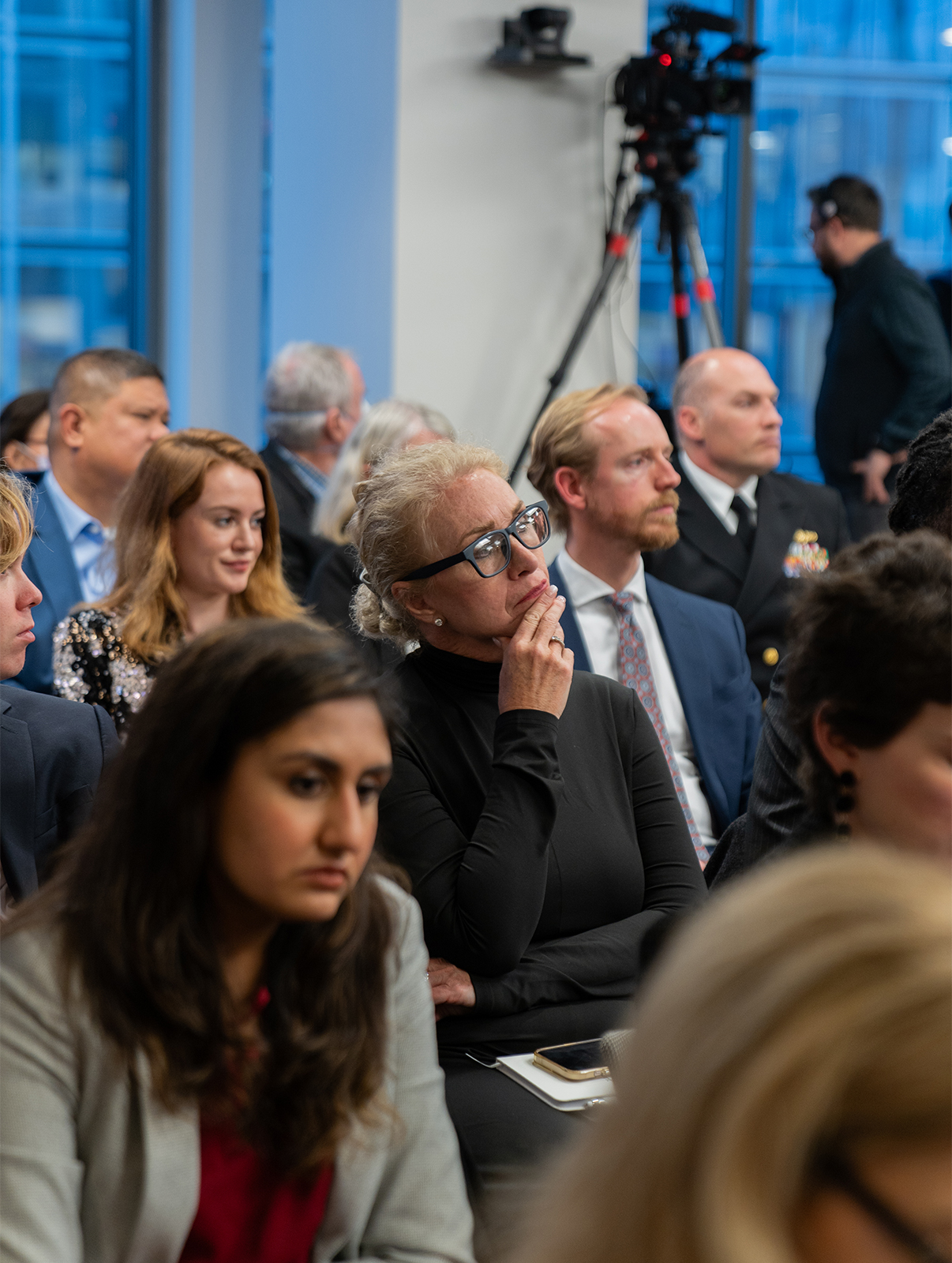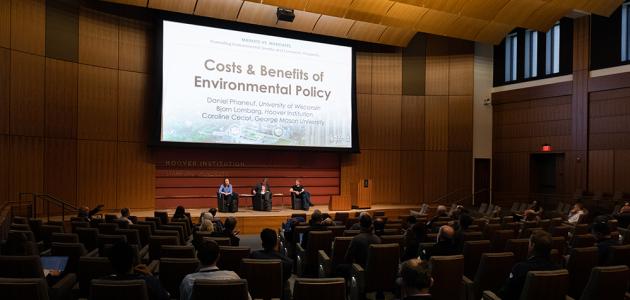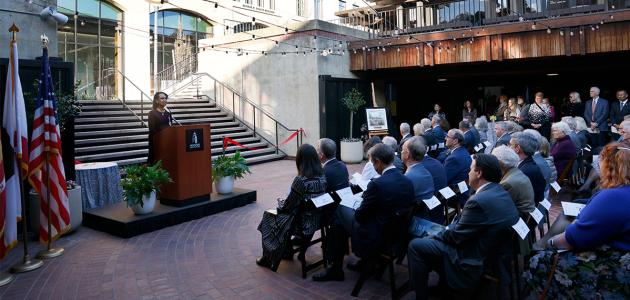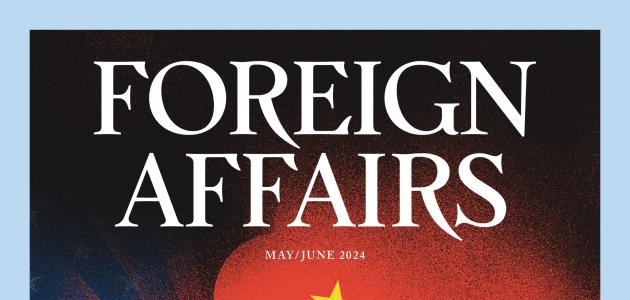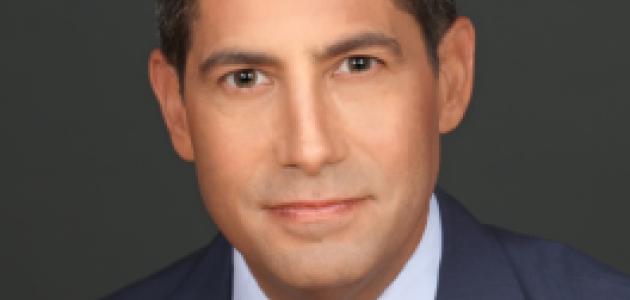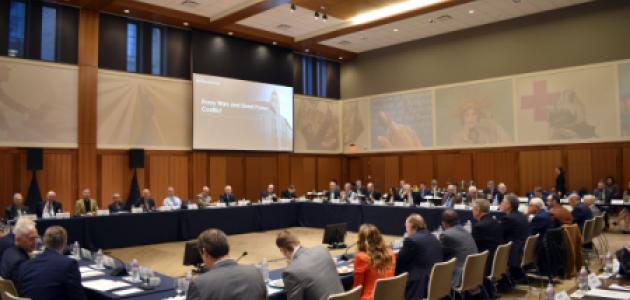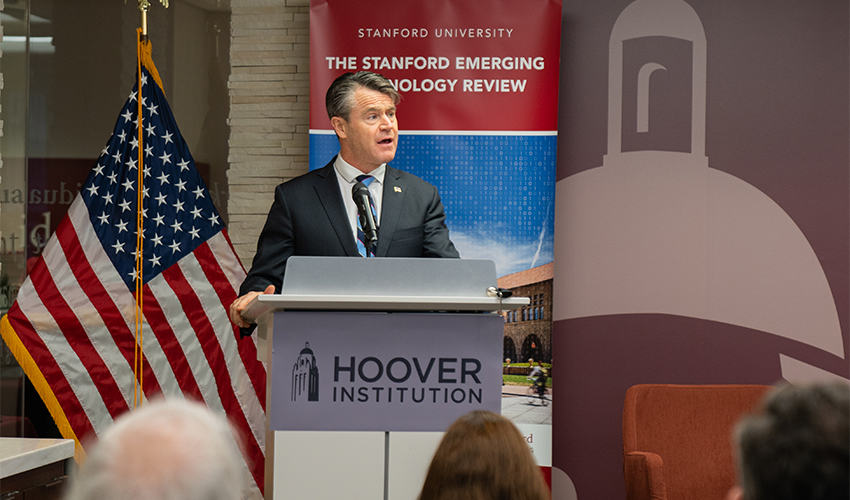
Hoover Institution (Washington, DC) – Contributor scholars, Stanford engineers all, of the Stanford Emerging Technology Review brought their insights to the nation’s capital last week.
The Stanford Technology Review initiative comprises both a publication of the same name and a wider project developed as a collaboration between the Hoover Institution and the Stanford School of Engineering. Through it, leading experts across the Stanford campus guide policymakers through developments and policy implications of frontier technologies that are shaping societies and economies — including space, semiconductors, sustainable technology, cryptography, artificial intelligence (AI), and others.
During the launch events, report contributors interacted and participated in discussions with leading policy makers, national security, defense, and intelligence officials, as well as members of the media. Media professionals represented outlets including Axios, Bloomberg, Defense One, The Messenger, National Public Radio, Financial Times, Reuters, Foreign Policy, ABC News, Politico, The Guardian, Washington Post, Wall Street Journal, and Wired.
Enhancing Situational Awareness in Frontier Technologies
The Stanford Emerging Technology Review publication will be updated regularly to keep leaders and citizens informed as these technologies transform and create new opportunities and challenges.

During a public event at Hoover’s Washington, DC offices on Thursday, January 25, Senator Todd Young of Indiana gave opening remarks, underscoring that American laws and institutions should keep pace with technological advancements, help unleash the creativity of citizens, and encourage future discovery.
“The comprehensive research and guidance provided by this report, in the clear and accessible way in which it has been presented, will be an incredible tool for policymakers in the coming years as we establish American leadership across these fields,” said Sen. Young about the Review.
Sen. Young, a Republican, reflected on how America’s technological competitiveness with the People’s Republic of China is an issue that garners bi-partisan support. He pointed to the CHIPS and Science Act of 2022, legislation which increased investment for the onshoring of critical semiconductor technologies. The original version of that bill was first imagined by Sen. Young and Democratic Senate leader Chuck Schumer of New York. The two would co-sponsor legislation in 2019, and again in 2021, aimed at boosting investment in research and development, and manufacturing, in technologies vital to economic development and national security.
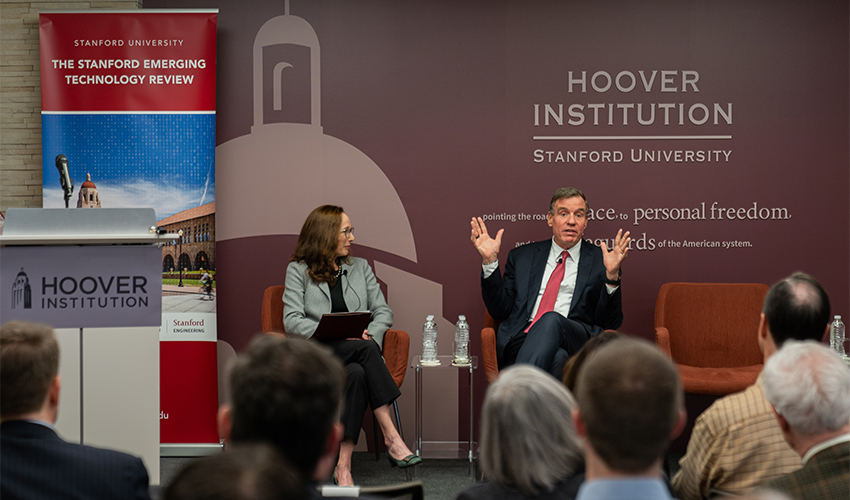
Sen. Young was followed by a conversation between Democratic Senator Mark Warner of Virginia, Chairman of the Senate Intelligence Committee, and Senior Fellow Amy Zegart, the Review’s cochair. During the conversation, Zegart characterized the Review as providing Washington “with an earlier situational awareness of what’s happening in technology.”
“If you have to read about [advancements in frontier technologies] in a paper or at a conference, you’re too late,” Zegart said.
Sen. Warner, whose visit to the Stanford campus two years ago sparked the idea behind developing the Review, said that the publication is part of an effort aimed at reaching the government at large, meant to inspire policymakers to reorient their understanding of how concepts such as national security are changing in an advancing world.
“So much of how government thinks about these things is in siloes, so the biggest challenge for me is how to redefine national security,” Sen. Warner told the audience. “It’s no longer about who has the most tanks, ships and guns, it’s about who’s going to win on all of these technologies.”
Sen. Warner said that the rapid emergence of AI is an example of a field where Washington needs to draft regulation promptly, possibly relying on advice from projects like the Review, and not let the field remain without proper oversight in the coming years.
“If we default to the traditional approach which is well, ‘If you put in guardrails, you’re going to slow down innovation and China’s going to beat us,’ . . . I think there are guardrails that don’t necessarily slow down innovation,” he said.
Opportunities and Challenges in Emerging Technologies
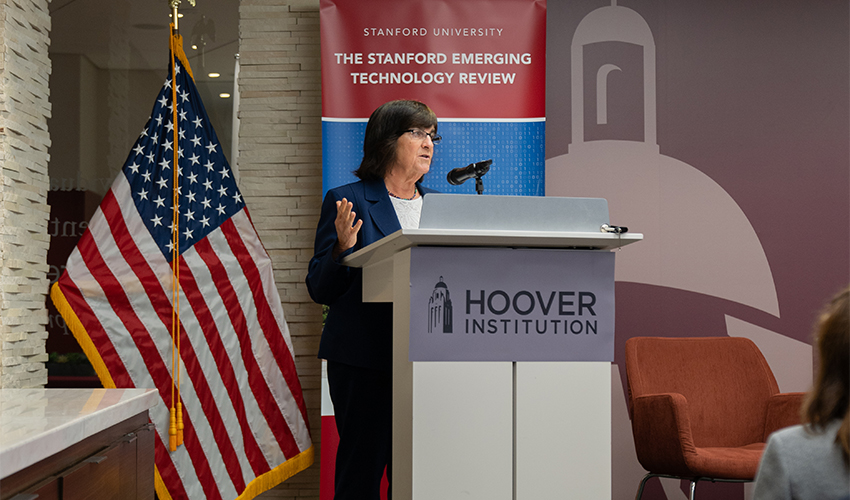
“We hope this project opens up a strong line of communication between those who are at the cutting edge of tech and those who are creating the policies around it,” Stanford School of Engineering dean and Review cochair Jennifer Widom maintained in introductory remarks to a panel featuring Review contributors.
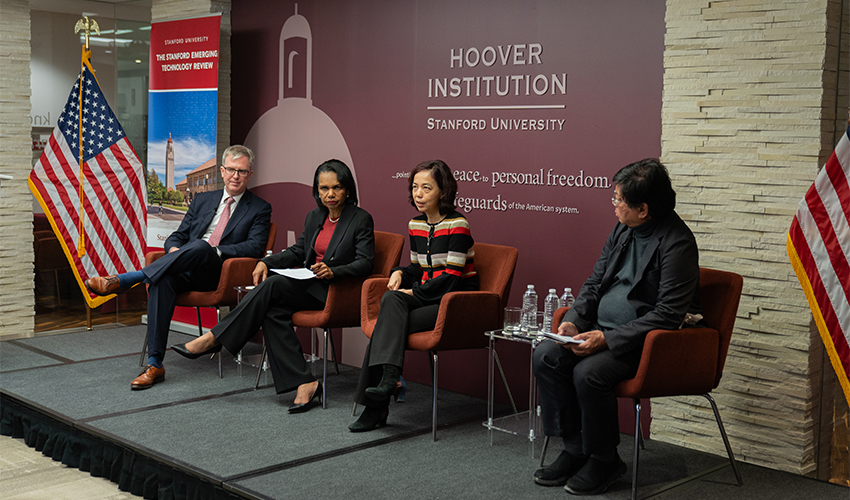
Panelists included, Drew Endy, Stanford professor of bioengineering and Hoover senior fellow; Fei-Fei Li, Stanford professor of computer science and co-director of the University’s Human-Centered Artificial Intelligence Institute (HAI); and Herb Lin, Hoover’s Hank J. Holland Fellow in Cyber Policy and Security, senior research scholar for cyber policy and security at the Center for International Security and Cooperation (CISAC), and the Review’s director. Condoleezza Rice, the 66th secretary of state and director of the Hoover Institution, moderated the discussion.
Widom added that the Review is also meant to cut through the “veil of mystery and even fear over the tech that is emerging” among the public.
In moderating the panel, Sec. Rice, who along with Zegart, Widom, and Senior Fellow John Taylor form the Review’s chaired leadership, expressed her appreciation for the engineers and scientists who collaborated with Hoover’s policy experts to publish the Stanford Emerging Technology Review.
Sec. Rice invited the experts to speak about what gave them hope about their respective fields but also what was causing challenges.
Fei-Fei Li said that her field has hit an inflection point in the past year in terms of a public awakening around AI. She maintained that rather than focus on some distant nightmare scenario about the potential for AI to end human civilization, she dwells on what AI could disrupt in the coming months or years.
“I don’t talk too much about the existential crisis [posed by AI],” Li said. “There are far more urgent tangible social risks—its impact on democracy or impact on the labor market because it shifts how we do tasks. That’s one thing that does concern me.”
She advocated for federal government support for extensive AI research at the university level, emphasizing the importance of healthy public sector that can sustain efforts for future discovery and the creation of trustworthy technology.
“Not a single American university can train a [large language model] on its own,” she explained with great concern.
On this point, Drew Endy agreed, also expressing hope that there was more funding for fundamental engineering research on projects that consist of basic science without an immediate commercial or medical application.
“I can get money from the NIH [National Institutes of Health] and the new ARPA-H [Advanced Research Projects Agency for Health] to cure diseases today. So where in our portfolio do we sustain fundamental investment in engineering research?”
Taking a wider-lens view of the challenges all emerging technologies face, Herb Lin raised some factors that continue to slow research and innovation.
One such barrier continues to be immigration policy and the inability to retain foreign talent, he explained. “US immigration policy seems specifically designed to keep out foreign talent,” Lin said. “We graduate people with PhDs and then kick them out, and they go to Canada.”
He also spoke of the rapid decentralization of technological research.
“Tech is devolving down to high school level,” Lin said. “Five years ago, it took a PhD student to do something, now a high school student can do it.”
Building on Lin’s observations, the Review identifies many other themes that cut across all emerging technologies.
Among them, the Review’s authors found that while US research universities like Stanford are “pivotal” in the innovation ecosystem, sustaining innovation requires a long-term research and development commitment from Washington.
Harnessing and Ensuring Safety of Innovation in Artificial Intelligence
On Friday, January 26, US Secretary of Commerce Gina Raimondo joined Sec. Rice and Fei-Fei Li for a discussion on actions that should be taken to harness the potential – as well as build guardrails – for Artificial Intelligence.
The event, co-presented by Hoover, Stanford University, and the US Department of Commerce took place at JP Morgan’s offices in Washington, DC, and was moderated by Miriam Vogel, president and CEO of Equal AI.
Sec. Raimondo said that although it is crucial for the United States to remain a leader in AI, especially as China and other adversaries are locked in a race to achieve advantages in this and other transformative technologies. However, she maintained that policy makers must remain vigilant of AI’s potential downsides.
“The adage in Silicon Valley, move fast and break things cannot be used here,” Sec. Raimondo argued. “My job is to make sure AI is developed in a way that is safe, secure, and people trust.”
Sec. Raimondo described how the Commerce Department is embarking on initiatives to provide guidance on the development of AI. In December, she explained, Commerce announced that it would be establishing the US Artificial Intelligence Safety Institute, which will be charged with leading “the US government’s efforts on safety and trust, particularly for evaluating the most advanced AI models.”
On Friday, Sec. Raimondo announced that the Commerce Department was going to begin using the Defense Production Act, mandating that companies participate in a survey, whereby they would be required to report events in which they train a new large language model.
Sec. Rice explained how technology ultimately embodies the values of those who use it. For example, constitutional norms like respect for privacy, the scope and limits of which are debated in democracies, don’t even exist in authoritarian systems. She stressed that those values need to be instilled through the education of budding scientists and engineers, particularly in civics at the post-secondary level.
“We have to make sure that they are educated and trained in a way that they also think about the values that are both potentially advanced by these technologies and potentially abridged by these technologies,” she said.
For Sec. Rice, countries that share values of freedom and human rights, such as the United States, European Union member nations, and the democracies of Asia, should strengthen cooperation on establishing standards on the use of AI and other emerging technologies.
Further, she argued that once standards are agreed upon between trusted allies, it is vital that they enlist key officials to ensure that those standards are permanently embedded in institutions of global governance such as the United Nations.
America Needs a Moonshot Mentality
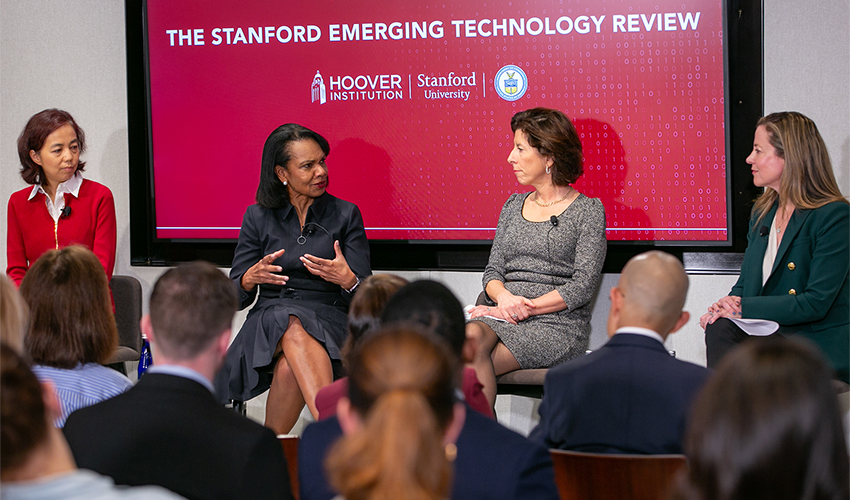
During the Friday session at JP Morgan, Li championed a moonshot mentality, advocating for tens of billions of dollars to be appropriated by Congress to support AI research.
Li described her participation in the founding of a National Artificial Intelligence Research Resource Task Force by the Biden administration in 2021. The mission of the task force is “to help develop a roadmap to democratize access to research tools that will promote AI innovation and fuel economic prosperity.”
Li and her colleagues have recommended at least $2.6 billion for the creation of a National AI research cloud. According to Li, this effort would “provide the computing chips and computing hardware, as well as a data repository to academia, where we can develop the next generation of cutting-edge AI research.”
Sec. Raimondo echoed Li’s advocacy for a moonshot mentality of AI, adding that such a large-scale national effort by the United States to maintain its status as leader in a fundamental technology, requires bi-partisan support for investment in research and development.
Watch The Event Video







